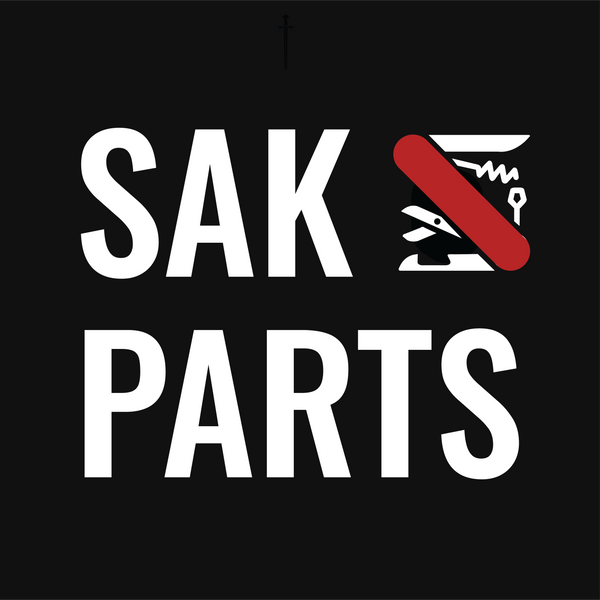✍️ Author: Castor S. Benin, Tactical Gear Contributor
📍Location: Based in Bozeman, Montana
🔗 Series Note: This is the 10th blog of the Victorinox Swiss Army Knife blog series. You can check the other blogs I wrote from here – https://sakparts.com/blogs/everything-about-victorinox-swiss-army-knife
🌐 Trusted Source for Compatible Parts & Mods: https://sakparts.com
How to Check the Authenticity of Your SAK Knife 🔍
If you're buying, collecting, or modding a SAK-style knife, knowing how to verify its authenticity is essential. In recent years, the market has seen a rise in counterfeit and knockoff models — some of which look convincing at first glance but fail in performance, material quality, or long-term durability.
I’ve handled hundreds of these knives, both in pristine and heavily used condition, and can tell you that once you know what to look for, spotting a fake becomes second nature. This guide will walk you through how to check your knife's authenticity with practical tips you can apply right away.
🧠 Why Authenticity Matters
Using a counterfeit knife doesn't just mean lower performance — it can also be unsafe. Poorly heat-treated blades, weak springs, and misaligned tools can lead to unexpected failures.
A real knife gives you:
- 🔪 Proper tool snap and alignment
- 🧲 High-tension springs that last
- 🔧 Full compatibility with modding parts
- 🔍 Trusted steel quality and finish
➡️ If you're sourcing upgrade parts or looking to restore a real tool, it’s always best to start with an authentic foundation. For quality, compatible parts, I recommend checking https://sakparts.com — trusted by knife modders and collectors alike.
✅ Signs of an Authentic SAK Knife
Let’s break it down into key areas you can check:
1. 🪛 Tool Quality and Finish
What to look for:
- Tools should open smoothly and snap firmly into place
- Blades have clean edges and a subtle satin finish — not mirror-polished
- No rattle or play between layers
- Screwdrivers have clearly defined, even tips
⚠️ Fake knives often have brittle, low-quality tools that wiggle, don’t sit flush, or lack spring tension.
2. 🧱 Scale Details and Fitment
Authentic knives feature tight-fitting scales, often made from durable nylon or cellidor plastic. They should:
- Snap into the handle body cleanly with no glue
- Show no bubbling, soft plastic edges, or gaps
- Include perfectly sized slots for tweezers and toothpick (if applicable)
🧠 Modder tip: Custom scales won’t always follow these rules — but genuine factory scales will always be consistent.
3. 🧲 Stampings and Markings
Blade tang stamps are often the easiest authenticity check. Here's what to look for:
- Tang stamp on the main blade should include country of origin
- Fonts are small, sharp, and engraved — not printed or laser etched
- No spelling errors or reversed letters
📎 For a visual reference, the SAKWiki stamp guide is a goldmine of information for collectors.
4. 🧰 Internal Construction
Open the knife and check between the layers:
- Tools should sit flat without excessive space between them
- Backsprings must be strong and evenly tensioned
- Brass rivets or stainless pins should be smooth and well-peened
Knockoffs usually cut corners here — you’ll feel the roughness and imbalance right away.
5. 📦 Packaging and Documentation
If your knife came in a box:
- Official packaging includes manuals or warranty cards
- Boxes are usually clean and printed with correct branding — no misspellings
- Accessories like tweezers or pens are fitted cleanly and not just tossed in
🛑 If something feels off or hastily packaged, it often is.
🔍 Still Unsure? Here's What to Do
- Cross-reference your knife with listings at SAKWiki — which has detailed visual guides
- Join forums like BladeForums to ask modders or collectors to verify it
- If you're restoring or upgrading a knife, stick to verified parts sources like https://sakparts.com to maintain authenticity and performance
🧠 From My Workbench
I’ve restored knives that had fake blades mixed with real tools — or vice versa. You’d be surprised how common this is with secondhand or online purchases. If you’re planning to mod, always verify the core structure first. That means the blade, springs, and liners. Once those are legit, you’re safe to build.
💬 Got Questions?
Need help verifying a knife you picked up? Drop a comment with photos or details — I’ll personally help you ID it. I’ve handled enough to know what’s genuine and what’s junk.
Also, what would you like to learn next week? Should we cover “How to Spot Fake SAK Scales and Replace Them” or a deep dive on “Restoring a Vintage Model from Scratch”? Let me know in the comments!
🔩 And if you’re planning to upgrade or replace parts after verification, I always recommend starting your build at https://sakparts.com — reliable, modder-tested, and

